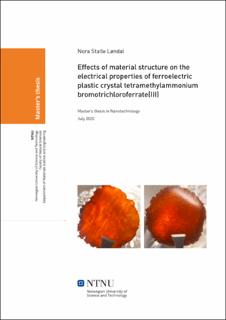| dc.contributor.advisor | Einarsrud, Mari-Ann | |
| dc.contributor.advisor | Walker, Julian | |
| dc.contributor.author | Løndal, Nora Statle | |
| dc.date.accessioned | 2021-09-28T18:11:14Z | |
| dc.date.available | 2021-09-28T18:11:14Z | |
| dc.date.issued | 2020 | |
| dc.identifier | no.ntnu:inspera:59544221:48026633 | |
| dc.identifier.uri | https://hdl.handle.net/11250/2785286 | |
| dc.description.abstract | Ferroelektriske materialer er foretrukne i en rekke applikasjoner, slik som mobiltelefoner, medisinsk ultralyd og digitalt minne, på grunn av at de har elektrisk polarisasjon som kan endre retning. Metalloksider, som er ledende på det ferroelektriske markedet, fungerer hensiktsmessig i mange applikasjoner, men det at de har et behov for høye prosesseringstemperaturer samt at de generelt er skjøre, gjør at det er begrenset hvor kompatible de er med neste generasjon av elektronikk. Plastiske krystaller har en plastisk mesophase som gjør prosessering og forming mulig ved moderate temperaturer. Et antall plastiske krystaller, slik som for eksempel tetrametylammonium-bromotrikloroferrat(III): [(CH3)4N]+[FeBrCl3]- (TMAFeBrCl3), har stabile ferroelektriske faser ved romtemperatur. Dette oppmuntrer til å utforske muligheten til å bruke ferroelectriske plastiske krystaller som et alternativ til de konvensjonelle metaloksidene. Målet med denne studien var å oppnå innsikt i hvordan egenskapene til plastiske krystaller avhenger av strukturelle faktorer, ved å studere forholdet mellom synteseforhold, struktur og egenskaper i den plastiske krystallforbindelsen TMAFeBrCl3. For å oppnå dette ble tre understudier utført på pressede agglomerater og presset pulver av den aktuelle forbindelsen. Dette innebærer en studie av mikrostruktur ved optiske bilder og sveipelektronmikroskopi (SEM), bestemmelse av strukturell fase ved røntgendiffraksjon (XRD), differensiell skanningskalorimetri (DSC) og vibrasjonsspektroskopi, samt karakterisering av materialets funksjonelle egenskaper gjennom måling av strøm som funksjon av spenning, samt analyse av feltavhengige hysteresekurver. Fra optiske bilder tyder det på at kornstørrelsen er forskjellig i de ulike pressede prøvene, men SEM viste ingen mikrostrukturell forskjell mellom dem. Fasebestemmelsene avslører at det er strukturelle ulikheter, i form av at prøvene presset fra pulver er mer utsatt for å ende opp med å ha den ikke-ferroelektriske Cmcm-fasen som hovedfase enn prøvene presset fra agglomerater. Karakterisering av elektriske egenskaper viser at alle prøvene har typisk ferroelektrisk karakteristikk, noe som tyder på at Cmcm-fasen gjennomgår en feltindusert faseovergang til den ferroelektriske fasen Amm2. | |
| dc.description.abstract | Ferroelectrics are desirable for a range of applications including mobile phones, medical ultrasound and digital memory, due to their switchable electrical polarisation. Metal oxides which govern the current market of ferroelectrics perform appropriately in a multitude of applications, but their prevailing requirement for high processing temperatures and generally brittle nature, demand high production energy and confine their compatibility in next generation electronics. Plastic crystals possess a plastic crystal mesophase that enables moderate temperature processing and shaping. A number of plastic crystals, like tetramethylammonium bromotrichloroferrate(III): [(CH3)4N]+[FeBrCl3] (TMAFeBrCl3), hold stable ferroelectric phases at roomtemperature, which encourage to explore plastic crystals ferroelectrics as a sustainable, light weight and shapeable option. The goal of this study was to gain insight on the structure-property relationship of plastic crystal ferroelectrics through a study of the synthesis-structure-property relationships of TMAFeBrCl3. To achieve this, three substudies were carried out on pressed agglomerate and pressed powder TMAFeBrCl3 samples. This includes a study of microstructure by optical imaging and scanning electron microscopy (SEM), structural phase determination using X-ray diffraction (XRD), differential scanning calorimetry (DSC) and vibrational spectroscopy, as well as, characterisation of the materials functional properties through current-voltage measurements and field dependent hysteresis behaviour. Optical imaging propose grain size difference between the different samples, but SEM shows no microstructural difference between them. Structural phase determination reveals structural difference, in terms of the pressed powder samples being more susceptible to end up having the non-ferroelectric Cmcm as majority phase than the pressed agglomerate samples. Characterisation of electrical properties shows that all samples exhibit typical ferroelectric behaviour, indicating that the Cmcm phase majority samples must experience a field induced phase transition into the ferroelectric Amm2 phase. | |
| dc.language | | |
| dc.publisher | NTNU | |
| dc.title | Effects of material structure on the electrical properties of ferroelectric plastic crystal tetramethylammonium bromotrichloroferrate(III) | |
| dc.type | Master thesis | |
